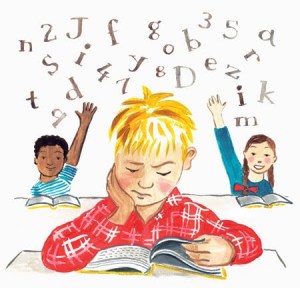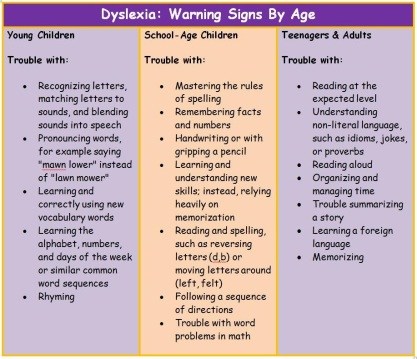What is Dyslexia?
Dyslexia is the most common learning disability effecting as much as 15% of the population of the United States. It is a learning disability that involves difficulty processing symbols, numbers, and written text causing reading difficulties.
These facts about dyslexia will help you get to know this learning disability:
They are from the DoSomething Website at: https://www.dosomething.org/facts/11-facts-about-dyslexia
“1. Dyslexia is the most common learning disability. Individuals with this medical condition have difficulty in the areas of language processing
2. 1 in 5 people suffer from dyslexia.
3. About 70 to 85% of children who are placed in special education for learning disabilities are dyslexic.
4. Dyslexia does not reflect an overall defect in language, but a localized weakness within the phonologic module of the brain (where sounds of language are put together to form words or break words down into sounds).
5. People with dyslexia are usually more creative and have a higher level of intelligence.
6. Those with dyslexia use only the right side of the brain to process language, while non-dyslexics use three areas on the left side of the brain to process language.
7. Children have a 50% chance of having dyslexia if one parent has it. And a 100% chance if both parents have it.
8. Dyslexia ranges from mild to severe. Around 40% of people with dyslexia also have ADHD. And those with dyslexia use about 5 times more energy to complete mental tasks.
9. Dyslexia is not a disease so there is no cure. It’s a learning disability that includes difficulty in the use/processing of linguistic and symbolic codes, alphabetic letters representing speech sounds or number and quantities.
10. Dyslexics do not “see” words backwards. The “b-d” letter reversal for example is mainly caused by deficits in interpreting left and right.
11. The U.S. Department of Health and Human Services estimates that 15% of the population has dyslexia.”
Causes of Dyslexia
Causes of dyslexia :
Dyslexia has been discovered to run in families and seems to be a result of genetics but this is not yet fact.
Differences can be seen in brain function between dyslexics and non-dyslexics in the areas of use in the brain. Dyslexics have less activity in their brains in areas important for reading and processing written word.
Symptoms and Characteristics of Dyslexia
Symptoms of dyslexia include difficulty blending and manipulating speech sounds, fluency in reading, and alphabetic knowledge.
The Following chart shows symptoms of dyslexia organized by age.
This chart was taken from the following website follow this link for more information.
http://comicphonics.files.wordpress.com/2013/05/dyslexia-warning-signs.jpg
Diagnosis of Dyslexia
Diagnosis of dyslexia is done through an evaluation. The evaluation of the student is completed by a professional or team of professionals with a strong knowledge of psychology and reading. The evaluation is completed by using a combination of tests selected by the evaluator. The results are then used to help accommodate the student and their unique educational needs.
Here are some great links for learning more about the evaluations and the different types of tests that are used.
National Center for Children with Learning Disabilities: On Dyslexia Testing
http://www.ncld.org/parents-child-disabilities/ld-testing/testing-for-dyslexia
International Dyslexia Association of Dyslexia Evaluation
http://www.interdys.org/EWEBEDITPRO5/UPLOAD/TESTINGANDEVALUATION.PDF
Educational Implications for Students With Dyslexia
Once a student is diagnosed with dyslexia there are many accommodations that can be made in the classroom to assist the learning process some of these implications include:
1. Extra time to complete tests and assignments.
2. Educational aids.
3.Repeated directions.
4. Use of assistive technology.
5.Books on tape.
6. Visual aids like graphic organizers.
7.Small group instruction.
8.Follow up with the individual after a group lesson.
9. Teaching study techniques.
10. Lightened workload.
11. Presenting information in multiple styles.
Dyslexia Advocacy Organization:
Follow the link below to get in touch with the Dyslexia Advocacy Organization . They are committed to educating parents about dyslexia and the rights of dyslexia students in the classroom.
http://www.dyslexiafoundation.org.nz/dyslexiaadvocacy/
Mentis Foundation:
Follow this link to connect to the Mentis Foundation a non-profit organization committed to helping dyslexics achieve.
http://www.mentisfoundation.org/
Eye to Eye:
This link will help you to connect your dyslexic child with a dyslexic adult mentor.



